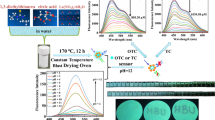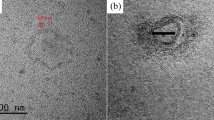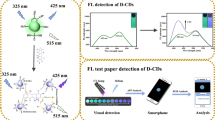Abstract
The authors describe dual-emission carbon nanodots containing blue emitters (BE; peak emission at 385nm under 315 nm excitation) and yellow emitters (YE; peak emission at 530 nm under 365nm excitation), and how they can be applied to direct and indirect determination of tetracyclines (TCs). The direct detection scheme is based on the finding that tetracycline (TET), oxytetracycline, chlortetracycline and doxycycline quench the two emissions of the carbon dots. While direct determination is rapid and convenient, it cannot differentiate between TCs. The indirect detection scheme, in contrast, is based on the finding that Al (III) ions enhance the fluorescence of the YE in the carbon dots, and that they cause a blue shift in emission. It is, however, known that TET forms a strong complex with Al (III), and this can inhibit the interaction between Al (III) and the YE, so that the fluorescence of YE is not enhanced and blue-shifted by Al (III) in the presence of TET. This finding is exploited in a fluorescence turn-on/off assay for TET that can distinguish TET from other TCs. The linear range of indirect determination for TET extends from 1 nM to 30 μM, and the limit of detection is 0.52 nM. The indirect method was successfully applied to the determination of TET in spiked milk, fish and pork, and recoveries ranged from 91.7 to 102 %.

High concentrations of tetracyclines quench the dual (blue and green) emission of carbon dots. Additionally, based on the fluorescence enhancement of yellow emitters by Al3+, an indirect turn-on/off detection of tetracycline is established with high selectivity and sensitivity.





Similar content being viewed by others
References
Fritsche TR, Strabala PA, Sader HS, Dowzicky MJ, Jones RN (2005) Activity of tigecycline tested against a global collection of enterobacteriaceae, including tetracycline-resistant isolates. Diagn Microbiol Infect Dis 52:209–213
Rodriguez JA, Espinosa J, Aguilar-Arteaga K, Ibarra IS, Miranda JM (2010) Determination of tetracyclines in milk samples by magnetic solid phase extraction flow injection analysis. Microchim Acta 171:407–413
Zheng DY, Zhu XL, Zhu XJ, Bo B, Yin YM, Li GX (2013) An electrochemical biosensor for the direct detection of oxytetracycline in mouse blood serum and urine. Analyst 138:1886–1890
Tan HL, Chen Y (2012) Silver nanoparticle enhanced fluorescence of europium (III) for detection of tetracycline in milk. Sensors Actuators B Chem 173:262–267
Zhang YD, Zheng N, Han RW, Zheng BQ, ZN Y, Li SL, Zheng SS, Wang JQ (2014) Occurrence of tetracyclines, sulfonamides, sulfamethazine and quinolones in pasteurized milk and UHT milk in China’s market. Food Control 36:238–242
Peres GT, Rath S, Reyes FGR (2010) A HPLC with fluorescence detection method for the determination of tetracyclines residues and evaluation of their stability in honey. Food Control 21:620–625
Sun JY, Gan T, Meng W, Shi ZX, Zhang ZW, Liu YM (2015) Determination of oxytetracycline in food using a disposable monymorillonite and acetylene black modified microelectrode. Anal Lett 48:100–115
Gajda A, Posyniak A (2015) Doxycycline depletion and residues in eggs after oral administration to laying hens. Food Addit Contam Part A 32:1116–1123
Kowalski P (2008) Capillary electrophoretic method for the simultaneous determination of tetracycline residues in fish samples. J Pharmacokinet Biopharm 47::487–493
Zhou L, Li DJ, Gai L, Wang JP, Li YB (2012) Electrochemical aptasensor for the detection of tetracycline with multi-walled carbon nanotubes amplification. Sensors Actuators B Chem 162:201–208
Hou J, Yan J, Zhao Q, Li Y, Ding H, Ding L (2013) A novel one-pot route for large-scale preparation of highly photoluminescent carbon quantum dots powders. Nanoscale 5:9558–9561
Feng YJ, Zhong D, Miao H, Yang XM (2015) Carbon dots derived from rose flowers for tetracycline sensing. Talanta 140:128–133
Yang XM, Luo YW, Zhu SS, Feng YJ, Zhuo Y, Dou Y (2014) One-pot synthesis of high fluorescent carbon nanoparticles and their applications as probes for detection of tetracyclines. Biosens Bioelectron 56:6–11
Shen L, Chen J, Li N, He PL, Li Z (2014) Rapid colorimetric sensing of tetracycline antibiotics with in situ growth of gold nanoparticles. Anal Chim Acta 839:83–90
An XT, Zhuo SJ, Zhang P, Zhu CQ (2015) Carbon dots based turn-on fluorescent probes for oxytetracycline hydrochloride sensing. RSC Adv 5: 19853–19858.
Yang XM, Zhu SS, Dou Y, Zhuo Y, Luo YW, Feng YJ (2014) Novel and remarkable enhanced-fluorescence system based on gold nanoclusters for detection of tetracycline. Talanta 122:36–42
Li GL, Fu HL, Chen XJ, Gong PW, Chen G, Xia L, Wang H, You JM, Wu YN (2016) Facile and sensitive fluorescence sensing of alkaline phosphatase activity with photoluminescent carbon dots based on inner filter effect. Anal Chem 88: 2720–2726.
Kang WJ, Ding YY, Zhou H, Liao QY, Xiao Y, Yang YG, Jiang JS, Yang MH (2015) Monitoring the activity and inhibition of alkaline phosphatase via quenching and restoration of the fluorescence of carbon dots. Microchim Acta 182:1161–1167.
Wang FX, Hao QL, Zhang YH, Xu YJ, Lei W (2016) Fluorescence quenchometric method for determination of ferric ion using boron-doped carbon dots. Microchim Acta (2016) 183:273–279.
Chang MMF, Ginjom IR, Ngu-Schwemlein M, Ng SM (2016) Synthesis of yellow fluorescent carbon dots and their application to the determination of chromium (III) with selectivity improved by pH tuning. Microchim Acta. doi:10.1007/s00604-016-1819-2.
Yan FY, Kong DP, Luo YM, Ye QH, He JJ, Guo XF, Chen L (2016) Carbon dots serve as an effective probe for the quantitative determination and for intracellular imaging of mercury (II). Microchim Acta 183:1611–1618
Ahmed GHG, Laíño RB, Calzón JAG, García MED (2015) Highly fluorescent carbon dots as nanoprobes for sensitive and selective determination of 4-nitrophenol in surface waters. Microchim Acta 182(1–2):51–59
Simões EFC, Leitão JMM, Silva JCG d, Esteves (2016) Carbon dots prepared from citric acid and urea as fluorescent probes for hypochlorite and peroxynitrite. Microchim Acta 183:1769–1777
Guo Y, Yang LL, Li WW, Wang XF, Shang YH, Li BX (2016) Carbon dots doped with nitrogen and sulfur and loaded with copper (II) as a “turn-on” fluorescent probe for cystein, glutathione and homocysteine. Microchim Acta 183:1409–1416
Rao HB, Liu W, ZW L, Wang YY, Ge HW, Zou P, Wang XX, He H, Zeng XY, Wang YJ (2016) Silica-coated carbon dots conjugated to CdTe quantum dots: a ratiometric fluorescent probe for copper (II). Microchim Acta 183:581–588
Liu DY, Qu F, Zhao XE, You JM (2015) Generalized one-pot strategy enabling different surface functionalizations of carbon nanodots to produce dual emissions in alcohol − water binary systems. J Phys Chem C 119: 17979–17987.
Qu F, Wang S, Liu DY, You JM (2015) Differentiation of multi-metal ions based on fluorescent dual-emission carbon nanodots. RSC Adv 5:82570–82575
Cháfer-Pericás C, Maquieira Á, Puchades R, Miralles J, Moreno A, Pastor-Navarro N, Espinós F (2010) Immunochemical determination of oxytetracycline in fish: Comparison between enzymatic and time-resolved fluorometric assays. Anal Chim Acta 662:177–185
Shang L, Dong SJ (2009) Design of fluorescent assays for cyanide and hydrogen peroxide based on the inner filter effect of metal nanoparticles. Anal Chem 81:1465–1470
Shao N, Zhang Y, Cheung SM, Yang RH, Chan WH, Mo T, Li KA, Liu F (2005) Copper ion-selective fluorescent sensor based on the inner filter effect using a spiropyran derivative. Anal Chem 77:7294–7303
Sapsford KE, Lorenzo B, Medintz IL (2006) Materials for fluorescence resonance energy transfer analysis: Beyond traditional donor–acceptor combinations. Angew Chem Int Ed 45:4562–4588
Gu C, Karthikeyan KG (2005) Interaction of tetracycline with aluminum and iron hydrous oxides. Environ Sci Technol 39:2660–2667
Machado FC, Demicheli C, Gamier-Suillerot A, Beraldo H (1995) Metal complexes of anhydrotetracycline. 2 absorption and circular dichroism study of Mg (II), Al (III), and Fe (III) complexes. Possible influence of the Mg (II) complex on the toxic side effects of tetracycline. J Inorg Biochem 60:163–173
Chen WR, Huang CH (2009) Transformation of tetracyclines mediated by Mn(II) and Cu(II) ions in the presence of oxygen. Environ Sci Technol 43:401–407
Dos Santos HF, Xavier ES, Zerner MC, De Almeida WB (2000) Spectroscopic investigation of the Al(III)-anhydrotetracycline complexation process. J Mol Struct 527:193–202
Acknowledgments
This work was supported by the National Natural Science Foundation of China (Youth Fund Project) (21405093) and the Scientific Research Foundation of Qufu Normal University (BSQD20130117).
Author information
Authors and Affiliations
Corresponding authors
Ethics declarations
Fei Qu and Zhe Sun contributed equally to this work. The authors declare that they have no competing interests
Electronic Supplementary Material
ESM 1
(DOC 9036 kb)
Rights and permissions
About this article
Cite this article
Qu, F., Sun, Z., Liu, D. et al. Direct and indirect fluorescent detection of tetracyclines using dually emitting carbon dots. Microchim Acta 183, 2547–2553 (2016). https://doi.org/10.1007/s00604-016-1901-9
Received:
Accepted:
Published:
Issue Date:
DOI: https://doi.org/10.1007/s00604-016-1901-9




